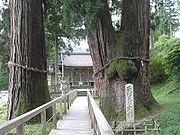
Great sugi of Kayano
Encyclopedia

Cryptomeria
Cryptomeria is a monotypic genus of conifer in the cypress family Cupressaceae formerly belonging to the family Taxodiaceae; it includes only one species, Cryptomeria japonica . It is endemic to Japan, where it is known as Sugi...
(Sugi) tree at Yamanaka Onsen
Yamanaka Onsen
is a city located in Kaga, Ishikawa Prefecture in Japan. It is in close proximity to Komatsu. It is famous for its onsen, or natural hot spring baths, and has many ryokan where guests can relax and enjoy the baths. The Daishoji River runs through the town, and it is a popular tourist spot for both...
in Kaga
Kaga, Ishikawa
is a city located in the southwest of Ishikawa Prefecture, Japan.Created as an old temple town, the city was greatly developed by the Maeda clan in the early Edo period...
, Ishikawa Prefecture
Ishikawa Prefecture
is a prefecture of Japan located in the Chūbu region on Honshū island. The capital is Kanazawa.- History :Ishikawa was formed from the merger of Kaga Province and the smaller Noto Province.- Geography :Ishikawa is on the Sea of Japan coast...
, Japan
Japan
Japan is an island nation in East Asia. Located in the Pacific Ocean, it lies to the east of the Sea of Japan, China, North Korea, South Korea and Russia, stretching from the Sea of Okhotsk in the north to the East China Sea and Taiwan in the south...
. One of the four trees believed to be sacred
Sacred
Holiness, or sanctity, is in general the state of being holy or sacred...
in the precincts of the Sugawara Shrine, it has received the distinction of designation as a Special Natural Monument
Natural Monument
A natural monument is a natural or natural/cultural feature of outstanding or unique value because of its inherent rarity, representative of aesthetic qualities or cultural significance....
from the Agency for Cultural Affairs
Agency for Cultural Affairs
The is a special body of the Japanese Ministry of Education . It was set up in 1968 to promote Japanese arts and culture. As of April 2007, it is led by the Commissioner for Cultural Affairs, Tamotsu Aoki....
of Japan.
The tree stands 54.8 m tall. At the base, it measures 11.5 m in circumference and 3.41 m across. At chest height, it is 9.6 m around and 3.0 m across. The tree splits into two trunks 4.9 m above ground level. In 1928, Professor Miyoshi Manabu (三好学) of Tokyo Imperial University
University of Tokyo
, abbreviated as , is a major research university located in Tokyo, Japan. The University has 10 faculties with a total of around 30,000 students, 2,100 of whom are foreign. Its five campuses are in Hongō, Komaba, Kashiwa, Shirokane and Nakano. It is considered to be the most prestigious university...
estimated the age of the tree to be 2,300 years.
The other three are 8.8 m, 6.65 m and 7.8 m at chest height and natural monument
Natural Monument
A natural monument is a natural or natural/cultural feature of outstanding or unique value because of its inherent rarity, representative of aesthetic qualities or cultural significance....
of Ishikawa Prefecture
Ishikawa Prefecture
is a prefecture of Japan located in the Chūbu region on Honshū island. The capital is Kanazawa.- History :Ishikawa was formed from the merger of Kaga Province and the smaller Noto Province.- Geography :Ishikawa is on the Sea of Japan coast...
.
Jōmon period
Jomon period
The is the time in Japanese prehistory from about 14,000 BC to 300 BC.The term jōmon means "cord-patterned" in Japanese. This refers to the pottery style characteristic of the Jōmon culture, and which has markings made using sticks with cords wrapped around them...
artifacts unearthed near the shrine establish that human habitation predates recorded history. Warriors including members of the Taira
Taira clan
The was a major Japanese clan of samurai in historical Japan.In reference to Japanese history, along with Minamoto, Taira was a hereditary clan name bestowed by the emperors of the Heian Period to certain ex-members of the imperial family when they became subjects...
, Minamoto
Minamoto clan
was one of the surnames bestowed by the Emperors of Japan upon members of the imperial family who were demoted into the ranks of the nobility. The practice was most prevalent during the Heian Period , although its last occurrence was during the Sengoku Era. The Taira were another such offshoot of...
, Asakura
Asakura clan
The ' are descendants of Prince Kusakabe , son of Emperor Temmu .The family was a line of daimyō which, along with the Azai clan, opposed Oda Nobunaga in the late 16th century...
, and the clan are said to have come to the shrine. In 1947, on the occasion of the second National Sports Festival of Japan
National Sports Festival of Japan
is the national premier sports event of Japan. The abbreviated name is Kokutai . The 65th National Sports Festival of Japan was held in October 2010 in Chiba Prefecture.- Emperor's Cup and Empress Cup Champions :...
(held in Ishikawa Prefecture), Emperor Shōwa (then known as Hirohito
Hirohito
, posthumously in Japan officially called Emperor Shōwa or , was the 124th Emperor of Japan according to the traditional order, reigning from December 25, 1926, until his death in 1989. Although better known outside of Japan by his personal name Hirohito, in Japan he is now referred to...
) visited the great sugi.
Source
- This article incorporates material from the article 栢野大杉 (Kayano Ōsugi) in the Japanese Wikipedia, retrieved on December 9, 2007.
External links
- The Great Cedar of Kayano Fauna and Flora, Ishikawa PrefectureIshikawa Prefectureis a prefecture of Japan located in the Chūbu region on Honshū island. The capital is Kanazawa.- History :Ishikawa was formed from the merger of Kaga Province and the smaller Noto Province.- Geography :Ishikawa is on the Sea of Japan coast...

